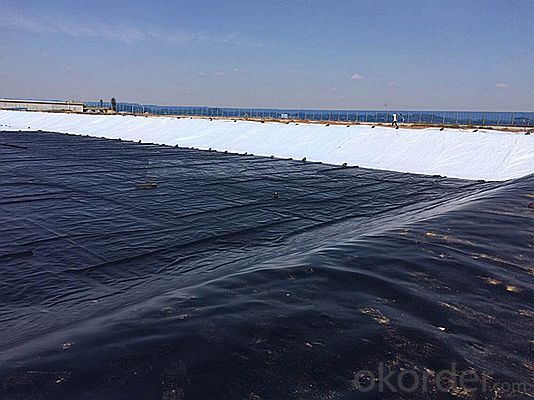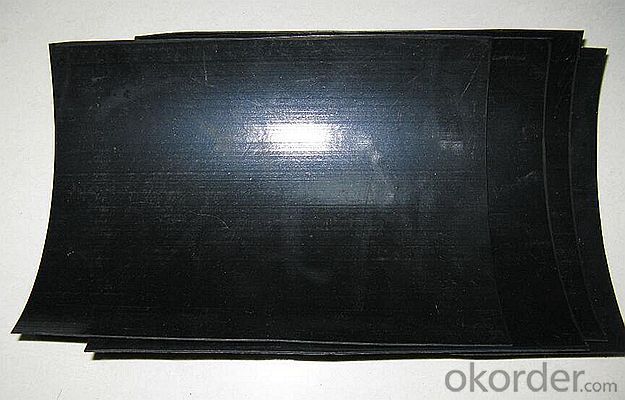Best Price High Quality Polyvinyl Chloride Geomembrane with Geotextile Fabric Non Woven
- Loading Port:
- China main port
- Payment Terms:
- TT OR LC
- Min Order Qty:
- 1000 g/m²
- Supply Capability:
- 10000000 g/m²/month
OKorder Service Pledge
OKorder Financial Service
You Might Also Like
Specification
Made from special virgin resin by blow film process.
1.thickness : 1.0mm --- 3.0mm,
2.width: Within 9 m ;
3.length:50-100m(or at request)
4.Material: HDPE,( LDPE, LLDPE, PVC,EVA).
5.Color: Black or as required.
Main Export Markets:
Asia
Australasia
Central/South America
Eastern Europe
Mid East/Africa
North America
Western Europe


FAQ:
Q: What kind of payments does jenor support?
A: T/T, L/C, Cash are accepted.
Q: Do you charge for the samples?
A: Accordeing to our company policy, the samples are free, we only charge the freight fee. And we will return the freight fee during the next order.
Q: Can you produce according to customers' design?
A: Sure, we are professional manufacturer, OEM and ODM are both welcome.
Q: Do you have other products?
A: Yes, please check the pictures:
Quality assurance
1.On a regular basis or as per your request,we entrust national testing agencies to conduct quality inspections
2. Strictly in accordance with the ISO9001-2008 international quality system standard,we monitor and manage the whole process throughout production,quality testing,and measurement to ensure product quality
3. For quality-related construction delay or substandard construction(except for damage or losses due to customer’s responsibility or irresistible natural disasters),we have refunding,replacement,and repair services.We will respond to customers’ feedbacks on quality issues within 24 hours.
Packaging & Shipping
Packing: PLASTIC FILM INSIDE, AND WOVEN BAG OUTSIDE
Shipping: About 15 days after receipt the deposit
- Q: What are the different geotextile testing methods?
- There are several different geotextile testing methods, including but not limited to, grab tensile strength testing, puncture resistance testing, tear resistance testing, burst strength testing, and permeability testing. These methods help assess the physical properties and performance of geotextiles in various applications.
- Q: Can geotextiles be used for slope stabilization?
- Yes, geotextiles can be used for slope stabilization. Geotextiles are commonly used in civil engineering to reinforce and stabilize slopes by providing strength and erosion control. They can be applied as a separating layer, a reinforcement layer, or a combination of both, depending on the specific requirements of the slope.
- Q: What are the cost considerations for geotextiles?
- The cost considerations for geotextiles include the material cost, installation cost, maintenance cost, and the overall lifespan of the geotextile. Additionally, factors such as the type and quality of the geotextile, the size of the project, and any specific requirements or regulations can also impact the cost. It is important to carefully evaluate these considerations to determine the most cost-effective solution for a geotextile application.
- Q: Hope expert expert to give the answer
- The ditch is the ditch at the edge of the roadbed, mainly used to collect and exclude a small amount of surface water within the roadbed and flow to the roadbed; drainage ditch is the ditch, cut ditch, roadbed near the water discharged to the bridge or road Where the ditch in the natural river ditch. Geotextile is a kind of synthetic high strength fiber material which is used to improve the bearing capacity of subgrade when the bearing capacity of the foundation is poor. It has many kinds of fiber materials. The purpose is to improve the bearing capacity and prevent the cracks in the road surface.
- Q: How are geotextiles classified?
- Geotextiles are classified based on their manufacturing process, material composition, and intended application.
- Q: Geotextile wholesale price of how much money, geotextile fabric manufacturers latest offer
- Geotextile wholesale, ranging from 5000-9000 yuan a ton. Geotextile manufacturers to answer your questions
- Q: Can geotextiles be used in coastal reclamation projects?
- Yes, geotextiles can be used in coastal reclamation projects. Geotextiles are often employed in these projects to provide erosion control, stabilization, and drainage. They help prevent soil erosion and promote vegetation growth, ultimately contributing to the successful reclamation of coastal areas.
- Q: What is the difference between woven and non-woven geotextiles?
- Woven geotextiles are made by weaving continuous individual yarns together, creating a strong and durable fabric. On the other hand, non-woven geotextiles are made by bonding or felting together synthetic fibers, resulting in a fabric that is not as strong or durable as woven geotextiles. Woven geotextiles provide higher tensile strength, better filtration, and are typically used in applications that require greater longevity and stability. Non-woven geotextiles, while less durable, are often used for filtration and separation purposes due to their high water flow rates and ability to retain fine particles.
- Q: How do geotextiles improve the performance of landfills?
- Geotextiles improve the performance of landfills by acting as a barrier or filter to prevent the migration of fine particles and contaminants from the waste into the surrounding soil and groundwater. They also enhance the stability and structural integrity of the landfill by providing reinforcement and erosion control.
- Q: With sand and gravel, geotextile do blind ditch how to construction
- Professional production geotextile manufacturers to answer
Send your message to us
Best Price High Quality Polyvinyl Chloride Geomembrane with Geotextile Fabric Non Woven
- Loading Port:
- China main port
- Payment Terms:
- TT OR LC
- Min Order Qty:
- 1000 g/m²
- Supply Capability:
- 10000000 g/m²/month
OKorder Service Pledge
OKorder Financial Service
Similar products
Hot products
Hot Searches
Related keywords


































